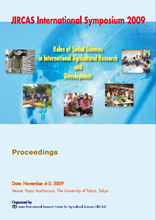Globalized World Economy and Agriculture in Developing Countries

The rise and fall and increased volatility of commodity prices, and especially food prices,
have captured headlines and stimulated a wide range of analytical activity and policy discourse.
It has caused and continues to cause hardship in many developing countries, has lead to social
unrest in scores of these countries and, according to FAO, has added 75 million people to the
number of undernourished and reversed progress toward the MDG hunger target. It is therefore
important to have a comprehensive understanding of the factors leading to the food price surge
in order to better analyze the market and policy implications for the near-term and long-term.
Added to the food price crisis of 2008 was the financial crisis of 2009, which also impacts food
and agricultural markets. All of these shocks are more severe for low income populations,
especially in food deficit areas.
Agricultural markets are traditionally very volatile due to weather variation and very
inelastic short run supply and demand. Also, rapid technological change since the end of WWII
has combined with inelastic demand for food to generate declining real agricultural prices.
Consumers have been the ultimate beneficiaries of agricultural technology, while farmers have
had to continually grow in size as well as to improve technological and financial practices to
offset price declines. Governments in high income countries adopted various support and
protective trade policies to protect their farmers from these price declines, which often
contributed further to low prices. This long-term decline in real prices has periodically been
interrupted by price spikes that were mostly caused by yield declines due to poor weather. The
largest and most prolonged price surge since the end of WWII was largely driven by
macroeconomic shocks, including the first and second oil price surge in the 1970s, high
inflation, dollar depreciation and the collapse of the Bretton Woods currency system. In real
terms, the price surge in the early 1970s was more severe than the recent one and was more
persistent than the weather induced price shocks that came in subsequent years. One important
question is whether the current price surge will ultimately lead back to the long run declining
real price path or will leave real prices on a higher long term path.
The increasing interdependence of food and energy markets is explored in terms of its long
term influence on commodity market behavior if the role of biofuels and energy prices continue to be an important and growing factor in food markets. These factors are explored further in the
context of possible future developments to assess whether each is expected to be a persistent
influence on markets and prices, a temporary or a very uncertain one. The most recent FAPRI
analyses for the next decade is analyzed and compared to longer term projections from other
sources. The results of this analysis have implications for future challenges and opportunities,
especially for agricultural development policy in developing countries.
What is described is a rather rapid transition from the decades-long period of falling real
prices of grains and food more generally to a new market environment in which commodity and
food prices are, higher, more volatile and more tightly linked to petroleum prices. Much of the
market behavior seen during the past few years is linked to the growing interdependence of
energy and agricultural markets. This market behavior and the conditions surrounding it are
likely to continue, and the prospects of returning to the patterns of the previous decades are less
likely.
We have seen world markets turn around and many commodity prices have declined
significantly from their peaks. However, this evidence of price retreat has yet to appear or is
appearing more slowly in many developing countries, as seen in FAO’s regional food price. It
means that markets that are insulated from or not well integrated with world markets may not in
the near-term see the benefits of increased world production or reduced prices in the world
market. Moreover, it is clear that rising commodity prices have more impact on food prices of
consumers in low income countries than on those in high income countries. Aside from the
higher share of income spent on food, the commodity price itself is a larger share of the
household food cost in a low income country. Likewise, the food import bills have grown faster
in developing countries. The food import bill of developing countries is estimated to increase by
nearly 35 percent from 2007-2008 and 32 percent for LIFDCs. This is after another sharp rise
the previous year. The scarcity of trade financing during the current financial crises only
compounds this problem.
The market conditions that have developed since 2005 and that seem likely to continue,
even if food price increases have abated somewhat, raise challenges and offer opportunities. The
challenge is how to provide safety nets for the most vulnerable populations that have been thrust
into a much more desperate financial situation because of sharply higher food prices. The
opportunity is that higher prices offer a chance to increase incomes from food production in
many rural areas where agriculture is the main source of income and employment. To meet
these challenges and exploit the opportunities, national and international policy actions are
being recommended.
| Date of issued | |
|---|---|
| Creator | William H. Meyers |
| Subject |
food prices financial crisis price volatility biofuels market outlook developing countries |
| Publisher | Japan International Research Center for Agricultural Sciences |
| Available Online | |
| Issue | 2009 |
| spage | 39 |
| epage | 49 |
| Rights | Japan International Research Center for Agricultural Sciences |
| Language | eng |
